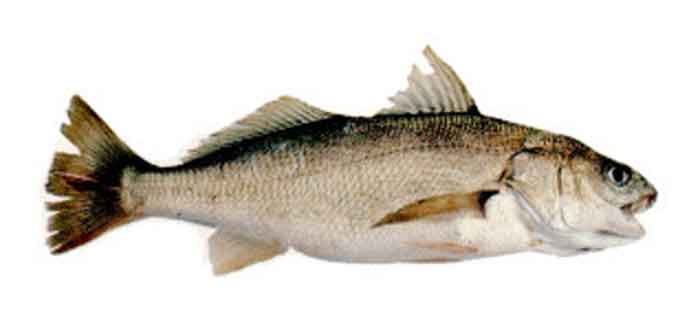Superregnum: Eukaryota
Cladus: Unikonta
Cladus: Opisthokonta
Cladus: Holozoa
Regnum: Animalia
Subregnum: Eumetazoa
Cladus: Bilateria
Cladus: Nephrozoa
Superphylum: Deuterostomia
Phylum: Chordata
Subphylum: Vertebrata
Infraphylum: Gnathostomata
Megaclassis: Osteichthyes
Superclassis/Classis: Actinopterygii
Classis/Subclassis: Actinopteri
Subclassis/Infraclassis: Neopterygii
Infraclassis: Teleostei
Megacohors: Osteoglossocephalai
Supercohors: Clupeocephala
Cohors: Euteleosteomorpha
Subcohors: Neoteleostei
Infracohors: Eurypterygia
Sectio: Ctenosquamata
Subsectio: Acanthomorphata
Divisio/Superordo: Acanthopterygii
Subdivisio: Percomorphaceae
Series: Eupercaria
Ordo: Perciformes
Subordo: Percoidei
Superfamilia: Percoidea
Familia: Sciaenidae
Genus: Genyonemus
Species: ?†G. karagiensis – G. lineatus
Name
Genyonemus Gill, 1861
References
Genyonemus – Taxon details on Integrated Taxonomic Information System (ITIS).
Genyonemus species list in FishBase,
Froese, R. & Pauly, D. (eds.) 2024. FishBase. World Wide Web electronic publication, www.fishbase.org, version 02/2024.
Vernacular names
Deutsch: Weißer Umber
English: White croaker
polski: Kulbiniec kalifornijski
中文: 條紋頦絲䱛

Genyonemus lineatus
White croaker ('Genyonemus lineatus') is a species of croaker occurring in the Eastern Pacific. White croakers have been taken from Magdalena Bay, Baja California, to Vancouver Island, British Columbia, but are not abundant north of San Francisco. White croakers swim in loose schools at or near the bottom of sandy areas. Sometimes they aggregate in the surf zone or in shallow bays and lagoons. Most of the time they are found in offshore areas at depths of 3 to 30 meters (10 to 100 ft). On rare occasions they are fairly abundant at depths as great as 200 meters (660 feet).
The white croaker is the only species of in the genus Genyonemus. Other common names for the fish include Pasadena trout, tommy croaker, and little bass.
Description
Identification
The body of the white croaker is elongate and somewhat compressed. The head is oblong and bluntly rounded, with a mouth that is somewhat underneath the head. The color is incandescent brownish to yellowish on the back becoming silvery below. The fins are yellow to white. The white croaker is one of five California croakers that have mouths located under their heads (subterminal). They can be distinguished from the California corbina and yellowfin croaker by the absence of a single fleshy projection, or barbel, at the tip of the lower jaw. The 12 to 15 spines in the first dorsal fin serve to distinguish white croakers from all the other croakers with sub-terminal mouths, since none of these has more than 11 spines in this fin.
White croakers eat a variety of fishes, squid, shrimp, octopus, worms, small crabs, clams and other items, either living or dead. While the ages of white croakers have not been determined conclusively, it is thought that some live as long as 15 or more years. Some spawn for the first time when they are between 2 and 3 years old. At this age they are only 12 to 15 cm (4.7 to 5.9 in) long and weigh less than 45 grams (0.099 pounds). Also have barbels on the lower lip. The largest recorded specimen was 41.4 cm (16.3 in), no weight recorded; however, a 36.8 cm (14.5 in) white croaker weighed 640 grams (1 lb 6½ oz).
Fishing information
These fish can be caught on almost any kind of animal bait that is fished from piers or jetties in sandy or sandy mud areas. In fact, they are so easily hooked that most anglers consider them a nuisance of the worst sort. If a person desires to fish specifically for white croakers a tough, difficult-to-steal bait, such as squid, is recommended. When hooked, they put up little or no fight. Fishing and catching is good throughout the year.
Cuisine
White croaker meat has been used as a co-ingredient in creating Crab stick.
References
Chao, L.; Espinosa Pérez, H. (2020). "Genyonemus lineatus". IUCN Red List of Threatened Species. 2020: e.T154755A130937337. doi:10.2305/IUCN.UK.2020-2.RLTS.T154755A130937337.en. Retrieved 20 November 2021.
Froese, Rainer; Pauly, Daniel (eds.). "Genyonemus lineatus". FishBase. February 2023 version.
Much of this article is copied from California Marine Sportfish by the California Department of Fish and Game, Marine Region; a public domain resource. [1]
Froese, Rainer; Pauly, Daniel (eds.). "Genyonemus lineatus". FishBase. May 2006 version.
Retrieved from "http://en.wikipedia.org/"
All text is available under the terms of the GNU Free Documentation License

